I am playing with R2DBC using Postgre SQL. The usecase i am trying is to get the Film by ID along with Language, Actors and Category. Below is the schema
this is the corresponding piece of code in ServiceImpl
@Override
public Mono<FilmModel> getById(Long id) {
Mono<Film> filmMono = filmRepository.findById(id).switchIfEmpty(Mono.error(DataFormatException::new)).subscribeOn(Schedulers.boundedElastic());
Flux<Actor> actorFlux = filmMono.flatMapMany(this::getByActorId).subscribeOn(Schedulers.boundedElastic());
Mono<String> language = filmMono.flatMap(film -> languageRepository.findById(film.getLanguageId())).map(Language::getName).subscribeOn(Schedulers.boundedElastic());
Mono<String> category = filmMono.flatMap(film -> filmCategoryRepository
.findFirstByFilmId(film.getFilmId()))
.flatMap(filmCategory -> categoryRepository.findById(filmCategory.getCategoryId()))
.map(Category::getName).subscribeOn(Schedulers.boundedElastic());
return Mono.zip(filmMono, actorFlux.collectList(), language, category)
.map(tuple -> {
FilmModel filmModel = GenericMapper.INSTANCE.filmToFilmModel(tuple.getT1());
List<ActorModel> actors = tuple
.getT2()
.stream()
.map(act -> GenericMapper.INSTANCE.actorToActorModel(act))
.collect(Collectors.toList());
filmModel.setActorModelList(actors);
filmModel.setLanguage(tuple.getT3());
filmModel.setCategory(tuple.getT4());
return filmModel;
});
}
The logs show 4 calls to film
2021-12-16 21:21:20.026 DEBUG 32493 --- [ctor-tcp-nio-10] o.s.r2dbc.core.DefaultDatabaseClient : Executing SQL statement [SELECT film.* FROM film WHERE film.film_id = $1 LIMIT 2]
2021-12-16 21:21:20.026 DEBUG 32493 --- [actor-tcp-nio-9] o.s.r2dbc.core.DefaultDatabaseClient : Executing SQL statement [SELECT film.* FROM film WHERE film.film_id = $1 LIMIT 2]
2021-12-16 21:21:20.026 DEBUG 32493 --- [ctor-tcp-nio-12] o.s.r2dbc.core.DefaultDatabaseClient : Executing SQL statement [SELECT film.* FROM film WHERE film.film_id = $1 LIMIT 2]
2021-12-16 21:21:20.026 DEBUG 32493 --- [actor-tcp-nio-7] o.s.r2dbc.core.DefaultDatabaseClient : Executing SQL statement [SELECT film.* FROM film WHERE film.film_id = $1 LIMIT 2]
2021-12-16 21:21:20.162 DEBUG 32493 --- [actor-tcp-nio-9] o.s.r2dbc.core.DefaultDatabaseClient : Executing SQL statement [SELECT language.* FROM language WHERE language.language_id = $1 LIMIT 2]
2021-12-16 21:21:20.188 DEBUG 32493 --- [actor-tcp-nio-7] o.s.r2dbc.core.DefaultDatabaseClient : Executing SQL statement [SELECT film_actor.actor_id, film_actor.film_id, film_actor.last_update FROM film_actor WHERE film_actor.film_id = $1]
2021-12-16 21:21:20.188 DEBUG 32493 --- [ctor-tcp-nio-10] o.s.r2dbc.core.DefaultDatabaseClient : Executing SQL statement [SELECT film_category.film_id, film_category.category_id, film_category.last_update FROM film_category WHERE film_category.film_id = $1 LIMIT 1]
2021-12-16 21:21:20.313 DEBUG 32493 --- [ctor-tcp-nio-10] o.s.r2dbc.core.DefaultDatabaseClient : Executing SQL statement [SELECT category.* FROM category WHERE category.category_id = $1 LIMIT 2]
2021-12-16 21:21:20.563 DEBUG 32493 --- [actor-tcp-nio-7] o.s.r2dbc.core.DefaultDatabaseClient : Executing SQL statement [SELECT actor.* FROM actor WHERE actor.actor_id = $1 LIMIT 2]
I am not trying to look for SQL optimizations(joins etc).I can definitely make it more performant. But the question in point is why i do see 4 SQL queries to Film table. Just to add i have already fixed the code. But not able to understand the core reason.Thanks in advance.
